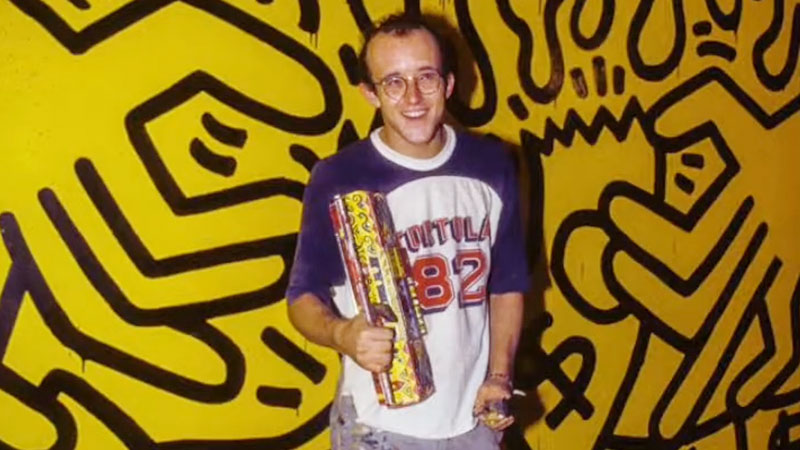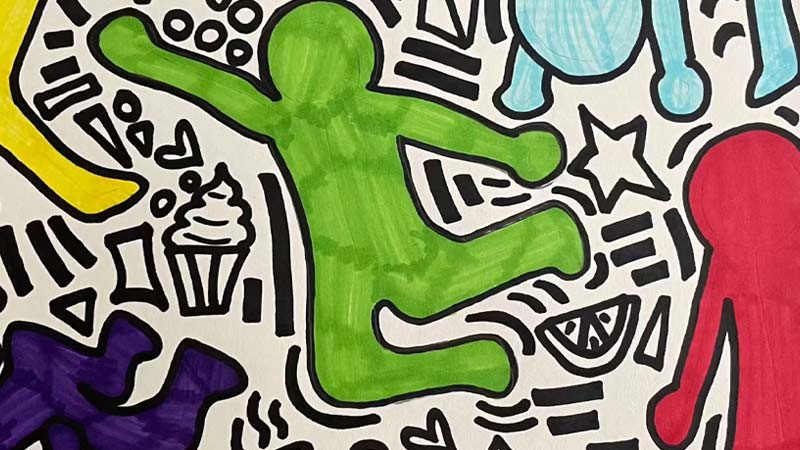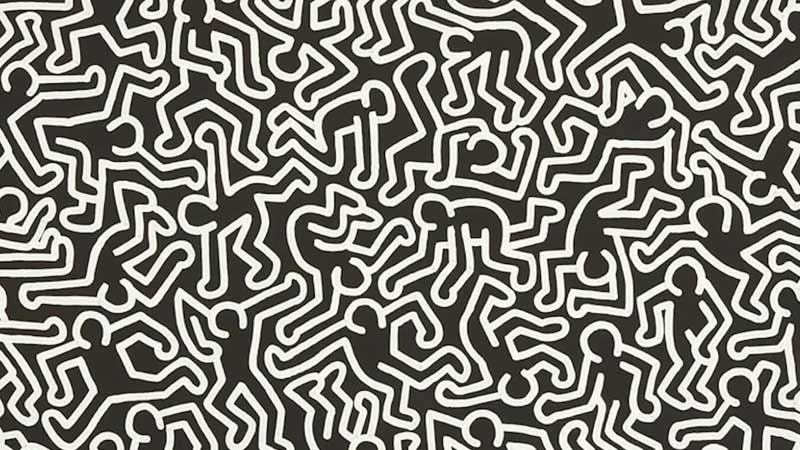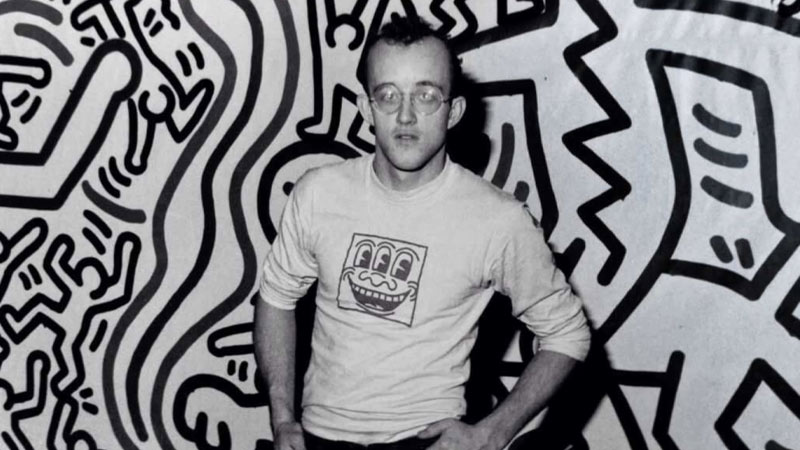Keith Haring was a versatile and innovative artist who made a significant impact on the world of contemporary art. Throughout his career, Haring experimented with a number of printmaking techniques, including lithography, screen printing, etching, woodcuts, and embossing.
These techniques allowed Haring to bridge the gap between his unique pieces and the reproduction of his imagery, making his popular pop art imagery more accessible to a wider audience.
In this article, we will explore the various printmaking techniques that Haring used throughout his career, showcasing the ways in which these techniques allowed him to experiment and push the boundaries of traditional printmaking.
Through his work, Haring demonstrated the power of printmaking to convey complex ideas and emotions, leaving a lasting legacy in the world of art.

Who Is Keith Haring?
Keith Haring (1958–1990) was an American artist and social activist known for his unique and instantly recognizable style that emerged in the New York City art scene in the 1980s.
His art often featured bold lines, bright colors, and simplified figures that conveyed a sense of energy and movement.
Key points about Keith Haring include:
Artistic Style
Haring’s art is characterized by its accessibility and a sense of immediacy.
He was known for using simple, almost cartoon-like figures, often featuring radiant babies, barking dogs, and dancing people. His use of vibrant colors and strong, dynamic lines became iconic.
Public Art and Subway Drawings
One of Haring’s notable contributions to the art world was his use of public spaces as a canvas.
He gained attention by creating chalk drawings on empty advertising panels in subway stations. These impromptu works became widely recognized and set the stage for his involvement in public art projects.
Social Activism
Beyond his artistic endeavors, Keith Haring was deeply engaged in social and political issues.
He used his art as a form of activism, addressing topics such as AIDS awareness, apartheid, drug addiction, and the crack cocaine epidemic. The “Radiant Baby” became a symbol for Haring’s message of love and unity.
Pop Shop
Haring was also known for his Pop Shop, a store in New York City where he sold affordable merchandise featuring his artwork.
The concept behind the shop was to make art accessible to a broader audience, challenging traditional notions of exclusivity in the art world.
AIDS Activism
In the late 1980s, Haring was diagnosed with AIDS. He became an advocate for AIDS awareness and activism, using his art to raise funds and awareness about the disease.
He established the Keith Haring Foundation in 1989 to support organizations involved in AIDS research and children’s programs.
Legacy
Keith Haring’s influence extends beyond his art; he played a significant role in bridging the gap between high and low art and making art more accessible to the general public.
His legacy lives on through his foundation, which continues to support various causes.
Tragically, Keith Haring’s life was cut short when he succumbed to AIDS-related complications in 1990 at the age of 31.
Despite his relatively short career, his impact on contemporary art and activism has endured, and his work continues to be celebrated and exhibited worldwide.
What Techniques Did Keith Haring Use?

Keith Haring employed various artistic techniques throughout his career, showcasing a versatility that contributed to the distinctive visual language for which he became renowned.
Here are some of the major Keith Haring art techniques:
Drawing and Line Art
Haring was known for his skillful use of continuous line drawing, where he would create images without lifting his pen from the paper. This technique contributed to the flowing and dynamic quality of his figures.
Painting
Haring often used acrylic paints, which allowed for vibrant colors and quick drying times. His paintings frequently featured bold, flat colors that emphasized the simplicity and clarity of his iconic characters.
Printmaking
Haring explored lithography, a printmaking technique that involves drawing on a stone or metal plate with a grease pencil or ink. This method allowed him to create multiple copies of his works with consistent quality.
Silkscreen printing involves applying ink through a stencil onto a mesh screen. Haring used this technique to produce bold and graphic prints, often in vibrant colors.
Public Murals
Haring gained international recognition for his public murals.
Using large expanses of walls as his canvas, he created dynamic and colorful murals in public spaces, contributing to the urban art movement.
Sculpture
In addition to two-dimensional works, Haring explored sculpture. He created carved wooden sculptures that reflected his distinctive characters in three-dimensional form.
Embroidery
Haring experimented with fabric and embroidery, translating his signature symbols into textiles. This added a tactile and craft-oriented dimension to his art.
Performance and Collaboration
Haring engaged in performance art, such as painting live at events and parties. His performances often involved creating spontaneous works in front of an audience.
Haring collaborated with various artists, musicians, and fashion designers, creating unique pieces that merged his iconic style with the aesthetics of other creative minds.
Technology
Toward the end of his career, Haring embraced digital technology and created artworks using computer programs. This adaptation demonstrated his openness to new artistic tools and methods.
Keith Haring’s techniques were not confined to a specific medium or style, showcasing his ability to adapt and innovate across various artistic forms.
His work remains influential, not only for its visual impact but also for the social and political messages embedded in his art.
Lithography of Keith Haring

Lithography was a crucial tool for Keith Haring in showcasing his bold, graphic style. This printing process allowed him to create editions of his iconic pop art imagery, making his work more accessible to a wider audience.
The process involved creating a reversed image on a flat stone or metal plate and treating the surface with chemicals so that ink would only stick to the image, before pressing the plate onto paper to transfer the ink. This enabled Haring to refine and perfect his designs, resulting in precise and vibrant prints.
The flat surface of the plate also allowed Haring to experiment with new forms of mark-making and to create dynamic and graphic images. Some of his most famous lithographs include “Untitled (Two Dancing Figures)” and “Untitled (Three Dancing Figures)”.
These prints are a testament to the importance of lithography in Haring’s work, and how it helped him to showcase his unique style.
Keith Haring was known for employing various artistic techniques in his work, and lithography was one of them.
Lithography is a printmaking technique that involves creating an image on a flat surface using oil-based ink and a stone or metal plate.
Here’s a brief overview of Haring’s use of lithography:
Collaboration with Printmakers
Keith Haring collaborated with master printmakers to produce lithographs. These printmakers played a crucial role in translating Haring’s distinctive style into the medium of lithography.
Iconic Imagery
Haring’s lithographs often featured his iconic and recognizable imagery, such as dancing figures, radiant babies, barking dogs, and other symbols that were central to his visual language.
The use of bold lines and vibrant colors, characteristic of his style, translated well into the lithographic medium.
Accessibility and Mass Production
Haring’s engagement with lithography was in line with his commitment to making art accessible to a wider audience.
Lithography allowed for the mass production of prints, enabling Haring to disseminate his work beyond traditional gallery spaces.
Social and Political Themes
Just like in his paintings and drawings, Haring used lithography to convey social and political messages. His prints often addressed issues such as AIDS awareness, apartheid, and other societal concerns.
The immediacy of lithography suited his desire to communicate urgent messages to the public.
Colorful Palette
Lithography allowed Haring to explore a vibrant and colorful palette. The use of bold, flat colors enhanced the visual impact of his prints.
The simplicity and directness of lithography aligned with Haring’s goal of creating art that was both visually striking and accessible.
Print Series
Haring created several lithographic print series during his career. These series often revolved around specific themes or subjects.
The repetition of certain motifs across multiple prints allowed him to explore variations within a theme.
Keith Haring’s lithographs, like his other works, continue to be exhibited and celebrated globally.
They provide insight into the artist’s engagement with various mediums and his commitment to using art as a tool for communication, activism, and societal awareness.
Keith Haring Screenprint

Screen printing was an important technique for Keith Haring in reproducing his work on a larger scale and making it more accessible to a wider audience.
This printmaking technique involved using a stencil to apply ink or paint onto a surface, by placing the stencil over a piece of paper and pressing ink through it onto the paper.
This process could be repeated multiple times to produce multiple prints, allowing Haring to quickly and efficiently create editions of his work.
Some of his most famous screen-printed works include “Untitled (Skateboard)” and “Untitled (The Party),” which showcase his iconic pop art imagery and use of bright, bold colors.
Screen printing allowed Haring to maintain the quality and integrity of his designs while also making them widely distributed and widely recognized. This helped to make his work some of the most popular and well-known in the world of contemporary art.
Etching
Etching was a crucial technique for Keith Haring in exploring new forms of mark-making and creating powerful images through simple, graphic forms.
The etching process involved etching an image into a metal plate and then applying ink to the plate before pressing it onto paper. The image was created by using an acid to etch the design into the metal plate, resulting in a precise and textured image.
Some of Haring’s most famous etchings include “Untitled (The Alphabet)” and “Untitled (The Last Supper),” which showcase his unique use of line and ability to create impactful images.
The metal plate also allowed Haring to experiment with new forms of mark-making such as cross-hatching and stippling, adding texture and dimension to his images.
This experimentation with etching led to the creation of limited-edition prints that were highly sought-after and highly valued by collectors and art lovers alike.
The etching process allowed Haring to refine and perfect his designs, creating images that were rich in detail and depth, and further solidifying his place as a leading figure in the world of contemporary art.
Woodcuts
Woodcuts were a crucial technique for Keith Haring in showcasing his innovative use of negative space and creating bold, graphic images. This printmaking technique involved carving an image into a block of wood and then printing the image onto paper.
The image was created by removing the areas of the block that were not part of the design, leaving behind a raised surface that held the ink. Some of Haring’s most famous woodcut prints include “Untitled (Two Dogs)” and “Untitled (Three Barking Dogs),” which showcase his bold, graphic style.
The process of carving the design into the block of wood allowed Haring to explore new forms of mark-making, such as the use of deep cuts and subtle shading, which added depth and dimension to his images.
The wood block also enabled Haring to create prints that were textured and rugged, adding a unique sense of depth and movement to his imagery. This experimentation with woodcuts led to the creation of prints that were highly sought-after and highly valued by collectors and art lovers alike.
Woodcuts allowed Haring to showcase his innovative use of negative space and to further solidify his place as a leading figure in the world of contemporary art.
Embossing by Keith Haring
Embossing was a crucial technique for Keith Haring in adding texture and dimension to his prints, creating a unique sense of depth and movement in his imagery.
This printmaking technique involved creating a raised surface on a piece of paper by pressing it between two metal plates.
The design was created using a metal plate with a raised surface that was pressed onto the paper, creating a raised, three-dimensional image.
Some of Haring’s most famous embossed prints include “Untitled (Heart)” and “Untitled (Baby),” which showcase his bold, graphic style and innovative use of texture and dimension.
Keith Haring, known for his bold and iconic visual language, also explored embossing as a technique in his artistic practice. Embossing involves creating a raised relief pattern or image on paper or another material.
While Haring is most famous for his paintings, drawings, and public murals, he occasionally employed embossing in his works to add texture and a tactile dimension to his creations.
Haring’s use of embossing might be seen in specific prints or limited edition works. Here are a few points related to Keith Haring’s exploration of embossing:
Texture and Sensory Experience
The use of embossing allowed Haring to introduce a tactile element to his art.
Viewers could physically feel the raised surfaces on the paper, enhancing the sensory experience of interacting with his works.
Limited Editions and Printmaking
Embossing is often associated with printmaking, and Haring produced various limited-edition prints during his career.
In these prints, embossing might be employed alongside other printmaking techniques, such as lithography or silkscreen printing, to achieve specific visual effects.
Signature Style in Relief
Haring’s signature style, characterized by bold lines and dynamic figures, could be translated effectively into relief images through embossing.
The simplicity and clarity of his designs lent themselves well to this technique, allowing the essence of his work to come through even in the absence of color.
Collectible Works
Limited edition prints by renowned artists, especially those featuring unique techniques like embossing, are often highly sought after by collectors.
Haring’s exploration of embossing adds another layer of interest and desirability to certain pieces within his body of work.
It’s worth noting that while embossing was not a primary technique for Haring, it demonstrates his versatility as an artist and his interest in experimenting with various mediums and processes.
As with any artist’s body of work, the specific instances of embossing in Haring’s portfolio would need to be examined on a case-by-case basis to understand the context and significance of each piece.
Keith Haring Techniques on Printmaking
| Technique | Definition | Examples of Haring’s Work | How it Allowed Haring to Experiment |
|---|---|---|---|
| Lithography | A printing process that uses a flat stone or metal plate to transfer an image onto paper. | “Untitled (Two Dancing Figures)”, “Untitled (Three Dancing Figures)” | Showcased bold, graphic style and unique use of color |
| Screen Printing | A printmaking technique that uses a stencil to apply ink or paint onto a surface. | “Untitled (Skateboard)”, “Untitled (The Party)” | Reproduced work on a larger scale |
| Etching | A printmaking technique that involves etching an image into a metal plate and then applying ink to the plate before pressing it onto paper. | “Untitled (The Alphabet)”, “Untitled (The Last Supper)” | Explored new forms of mark-making |
| Woodcuts | A printmaking technique that involves carving an image into a block of wood and then printing the image onto paper. | “Untitled (Two Dogs)”, “Untitled (Three Barking Dogs)” | Showcased innovative use of negative space |
| Embossing | A printmaking technique that involves creating a raised surface on a piece of paper by pressing it between two metal plates. | “Untitled (Heart)”, “Untitled (Baby)” | Added texture and dimension to prints |
FAQs
Keith Haring’s printmaking work is significant because it allowed him to make his iconic pop art imagery more accessible to a wider audience. By experimenting with various printmaking techniques, Haring was able to bridge the gap between his unique pieces and the reproduction of his imagery, making his work more widely recognized and widely distributed.
The process of creating a lithograph involves creating a reversed image on a flat stone or metal plate, treating the surface with chemicals so that ink will only stick to the image, and then pressing the plate onto the paper to transfer the ink.
The process of screen printing involves creating a stencil, placing the stencil over a piece of paper, and pressing ink or paint through the stencil and onto the paper to create the image. This process can be repeated multiple times to produce multiple prints.
Etching and engraving are similar printmaking techniques, but the main difference between the two is the method used to create the design. Etching involves etching an image into a metal plate using acid, while engraving involves carving the design into the plate using a tool.
The process of creating a woodcut print involves carving an image into a block of wood and then printing the image onto paper. The image is created by removing the areas of the block that are not part of the design, leaving behind a raised surface that will hold the ink. The inked block is then pressed onto paper to transfer the image.
Embossing is considered a form of printmaking because it involves creating a raised surface on a piece of paper by pressing it between two metal plates. The design is created by using a metal plate with a raised surface that is pressed onto the paper, creating a raised, three-dimensional image. This process can be repeated multiple times to produce multiple prints.
Conclusion
Keith Haring’s technique was a fusion of bold lines, vivid colors, and a unique blend of street and pop art influences. His ability to communicate complex social messages through deceptively simple symbols was his hallmark.
By examining Haring’s artistic journey, we’ve gained insights into the methods and materials that fueled his creativity. His commitment to making art accessible to all, whether through public murals or charity projects, added a layer of depth to his technique.
Haring’s legacy endures, reminding us that art can be a powerful tool for both self-expression and societal change.
As we continue to appreciate his contributions, we’re inspired not only by what he created but also by the techniques he employed to leave an everlasting impact on the world of art.
Leave a Reply